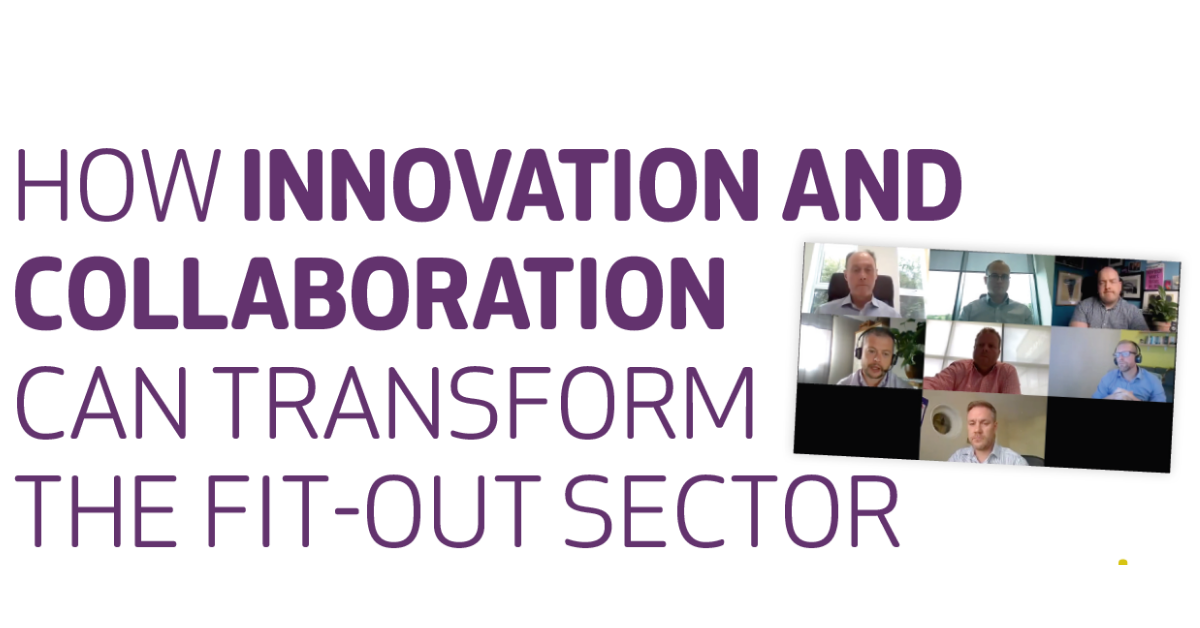FIS is a trade association partner with NBS, the leading specifi cation platform for the construction industry, which aims to drive up standards and compliance through information sharing and best practice amongst construction professionals.
One of the first events to come out of this partnership was a joint webinar held in September, ‘Deconstructing Fit-out: Is greater collaboration a pipedream?’ It was a fascinating and thought-provoking session on whether greater collaboration during the construction project timeline is a reality or just something to hope for.
The expert panel featured representatives of all stages of the supply chain – and looked at a ‘typical’ technical interiors project, all the way through from concept to completion including where they think the barriers to better collaboration might lie.
The panel analysed the various stages of work, what happens when, and looked at how our industry can use digital solutions to communicate, collaborate, avoid re-work, manage risk and design liability and eliminate waste. It was a hefty agenda but the discussions were relevant to every part of the fit-out sector and provoked some interesting side debates.
Meet the panel
Chaired by Lee Jones, Head of Manufacturer Solutions at NBS, the expert panel comprised:
• Iain McIlwee, CEO, FIS
• Paul Swaddle, Head of Technical Solutions, NBS
• Richard Jones, FIS Vice President, and Managing Director, Paramount
• Tim Spencer, Technical Manager, Rockfon
• Steve Watson, National Supply Chain Director, Willmott Dixon Construction Limited; and
• James McQuaid, Director – Systems & Productivity, Errigal Contracts Limited
To keep the discussions rolling, all attendees to the webinar had their microphones muted but were encouraged to submit questions by email to be put to the panel at the end.
To begin the webinar, Richard Jones talked through the stages of a typical tendered interiors project from a contractor’s point of view, starting with initial contact he would receive from a client.
Steve Watson emphasised the undoubted benefi ts his company enjoys, of involving the complete supply change chain as much as possible and as early as possible. This was echoed by James McQuaid who said: “As a subcontractor we are being asked to engage earlier in the tender stage which is beneficial to everyone, but it is just a starting point – for true collaborative planning we need to make better use of accurate data, it quickly identifies risks or potential issues but suffi cient training in its use is necessary.”
Talking of ‘risk’, the sector knows that risk has to be managed from start to finish but Iain McIlwee, said: “We need to differentiate between risk management and risk mitigation. There are many examples where a badly communicated design introduces a defect down the line, or contracts are issued with phrases such as ‘contractor’s choice’.
“We have to accept that you can’t just drop a risk into a contract through the process. FIS has worked with a number of trade associations across the sector to produce a series of detailed guides to help everybody in the supply chain to make the right decisions. The Best Practice Guides are an essential guide to selection, planning and installation in specialist areas and are designed to give an overview and support understanding for all involved in the process.
From an architect’s perspective, Paul Swaddle would like to see a more beefed-up approach to competency, he said: “Competency monitoring is mentioned in the Draft Safety Bill and we need it to be completely transparent. We have to be aware of exactly what is happening at every stage of the project – who was involved and who makes the decisions.
“I welcome the idea to improve competency and in a modern construction industry we should expect everyone to achieve a level of competency then maintain it.”
Transparency came up again in this debate, this time around the issue of contracts again, Tim Spencer said that getting involved right at the contract stage is critical, saying: “We should be confident in saying that contracts need amending to include explicit levels of detail before they are re-issued for consideration.
These snippets of the debate should have whetted your appetite to learn more, so you can watch the complete event at: www.tinyurl.com/y6bq44yk
The strategic partnership between FIS and NBS aims to drive up standards and will ensure that industry-wide compliance and best practice are pooled and shared with specifiers, to drive further innovation in the sector.
FIS members can access a discount of 10% on the fi rst year of a new NBS Source subscription. Visit www.thefis.org/membership-hub/memberbenefits/member-benefits-technical/nbs-source/


